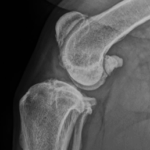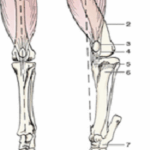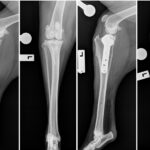
Thyroid gland from a cat.
Why is my cat eating lots but losing weight?
This is quite a common question from owners of elderly cats. The owners often report that the cat always seems to be looking for food, is a bit restless, and losing weight. As soon as we hear this, we start thinking about a number of potential causes, but particularly about a thyroid problem called hyperthyroidism.
Hyperthyroidism is a relatively common condition in older cats caused by a small tumour in the thyroid gland. The tumours are normally benign (which means they don’t tend to spread to other parts of the body), but are active in producing thyroid hormone.
The role of the thyroid hormone is to regulate the body’s metabolic rate. The production of thyroid hormone is normally tightly controlled by the body so there is just the right amount to keep us active, warm and healthy. The tumours which grow in the thyroid gland don’t respond to the body’s control mechanism, so continuously produce excessive amounts of hormone. This leads to an increased metabolic rate and multiple other issues.
The first step for us to investigate this issue is a thorough physical examination. We need to make sure there is no other reason for the cat’s signs. For example, a cat with dental disease may constantly head to the food bowl because it’s hungry but it’s too painful to eat. We also need to make sure that there are no other issues which might impact on our decision to treat the hyperthyroidism.
We find that most cats with hyperthyroidism have a very high heart rate, and can be higher than 240 beats per minute. A normal cat’s heart rate is around 160-180. In some cases we can also feel a small lump in the affected thyroid gland, which is located in the neck next to the trachea.
The next step is a blood test. This is to check the general health of the cat as well as measuring thyroid hormone levels. It is very important to measure kidney function at this point, as hyperthyroidism can affect kidney function quite dramatically.
Once hyperthyroidism has been confirmed, we have a few treatment options:
- Medical management: This involves daily or twice daily medication to block thyroid hormone production. This may be in the form of a liquid, tablet or a product which is applied to the cat’s skin.
- Surgery: We can surgically remove many of these thyroid tumours. This is a good option for many cats as it avoids the need for life-long medication and monitoring, plus can be cheaper in the long run. We normally need to use medical management for 3-4 weeks to stabilise the patient prior to surgery
- Radioiodine therapy: This involves the injection of a radioactive form of iodine, which is picked up by the thyroid gland and destroys the tumour. This is not currently available in Western Australia.
Your vet will discuss the best option for your pet once the condition has been diagnosed, as there is no one-size-fits-all solution to this problem.
Early intervention is critical for this disease, as it contributes to kidney damage and may increase the risk of stroke or other cardiovascular problems. If you’re worried about your cat, please call us today.



